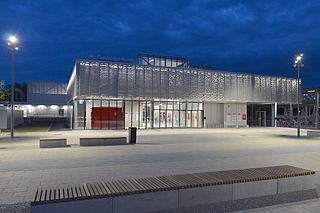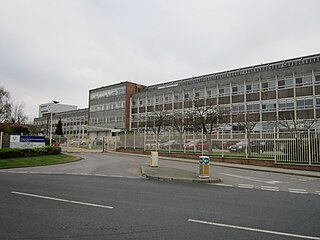
Cambridge is a university city, non-metropolitan district and the county town of Cambridgeshire, England. It is located on the River Cam approximately 55 miles (89 km) north of London. As of the 2021 United Kingdom census, the population of Cambridge was 145,700. Cambridge became an important trading centre during the Roman and Viking ages, and there is archaeological evidence of settlement in the area as early as the Bronze Age. The first town charters were granted in the 12th century, although modern city status was not officially conferred until 1951.

Addenbrooke's Hospital is a large teaching hospital and research centre in Cambridge, England, with strong affiliations to the University of Cambridge. Addenbrooke's Hospital is located on the Cambridge Biomedical Campus. It is run by Cambridge University Hospitals NHS Foundation Trust and is a designated academic health science centre. It is also the East of England's major trauma centre and was the first such centre to be operational in the United Kingdom.

The Cambridge Science Park, founded by Trinity College in 1970, is the oldest science park in the United Kingdom. It is a concentration of science and technology related businesses, and has strong links with the nearby University of Cambridge.

Sir Lionel Alexander Bethune Pilkington, known as Sir Alastair Pilkington, was a British engineer and businessman who invented and perfected the float glass process for commercial manufacturing of plate glass.
Sinclair Research Ltd is a former British consumer electronics company founded by Clive Sinclair in Cambridge. It was originally incorporated in 1973 as Westminster Mail Order Ltd, renamed Sinclair Instrument Ltd, then Science of Cambridge Ltd, then Sinclair Computers Ltd, and finally Sinclair Research Ltd. It remained dormant until 1976, when it was activated with the intention of continuing Sinclair's commercial work from his earlier company Sinclair Radionics, and adopted the name Sinclair Research in 1981.

Hills Road Sixth Form College is a public sector co-educational sixth form college in Cambridge, England, providing full-time A-level courses for approximately 2400 sixth form students from the surrounding area and a variety of courses to around 4,000 part-time students of all ages in the adult education programme, held as daytime and evening classes.

BBC East is one of BBC's English Regions covering Norfolk, Suffolk, Essex, Cambridgeshire, Northamptonshire, Bedfordshire and parts of Hertfordshire and Buckinghamshire. It is headquartered in The Forum, Norwich since 2003. It was also separated into two areas, one with the East area covering mostly in Norfolk, Suffolk & Essex, and another from the West area which covers from Cambridge, serving mostly Cambridgeshire, Northamptonshire and the three counties.

The Cambridgeshire High School for Boys was founded as the Cambridge and County School for Boys in Cambridge, England, in 1900.

Trowell services is a motorway service station off the M1 motorway in Trowell, Nottinghamshire, England, situated north of Junction 25. Opened in 1967 by Mecca Leisure, it is currently owned by Moto. The services are situated near Nottingham.

Robert James Mair, Baron Mair, is a geotechnical engineer and Emeritus Sir Kirby Laing Professor of Civil Engineering and director of research at the University of Cambridge. He is Head of the Cambridge Centre for Smart Infrastructure and Construction (CSIC). He was Master of Jesus College, Cambridge, from 2001 to 2011 and a fellow of St John's College, Cambridge, from 1998 to 2001. In 2014 he was elected a vice president of the Institution of Civil Engineers and on 1 November 2017 became the Institution's president for 2017–18, its 200th anniversary year. He was appointed an independent crossbencher in the House of Lords in 2015 and is currently a member of its Select Committee on Science and Technology.

Cambridge North railway station is a railway station located in the Cambridge suburb of Chesterton, close to Cambridge Science Park. The station is on the Fen Line, which runs from Cambridge to King's Lynn. It connects to the Cambridgeshire Guided Busway, and provides an interchange with Park & Ride and local bus services.

Ely is a cathedral city and civil parish in the East Cambridgeshire district of Cambridgeshire, England, about 14 miles (23 km) north-northeast of Cambridge and 80 miles (130 km) from London.

Pfizer UK is the principal subsidiary of the multinational pharmaceutical company Pfizer in the United Kingdom.

The Unilever Research & Development Port Sunlight Laboratory is the multinational consumer goods company Unilever's main research and development facility in the United Kingdom. It is located in Bebington, Merseyside.

Barrington Chalk Pit is a 97.1-hectare (240-acre) geological Site of Special Scientific Interest near Barrington in Cambridgeshire. It is a Geological Conservation Review site.
Huntingdon Greyhound Stadium was a greyhound racing stadium in Huntingdon, Cambridgeshire.

Unilever Gloucester is a large food manufacturing site in the north-east of Gloucester, England, that produces all of the makes of Unilever ice cream for the UK.
The Institute of Naval Medicine is the main research centre and training facility of the Royal Navy Medical Service.
The Shell Technology Centre was a chemical and oil products research institute in northern Cheshire, near Stanlow, owned by Anglo-Dutch Shell.

Chesterford Park Research Station was a former crop protection research centre in Essex, and is now a science park with biotechnology companies.


















